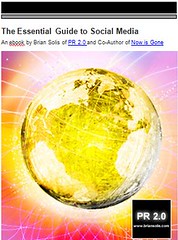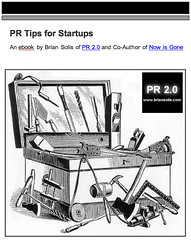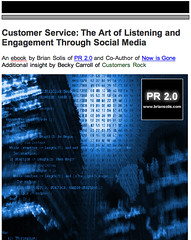Social Media Continues to Rival Traditional Media

As each day passes, we're presented with new information that documents the decline of traditional media in favor of online counterparts and new media competitors. It seems that newspapers are among the hardest hit with circulation and print advertising down - forcing layoffs across the country.
The Newspaper Association of America (NAA) recently released a study showing newspaper Web sites attracted an average of about 66 million unique visitors in the first quarter, up about 12 percent over the same period a year ago.
The problem for publishers has been turning that online traffic growth into revenues. Online advertising at newspapers grew 18.8 percent last year, according to NAA figures, but that wasn’t enough to offset a 9.4 percent decline in print advertising. Total newspaper advertising last year, print and online, declined 7.9 percent.
Is Social Media to blame for the erosion in traditional media consumption and advertising revenues? Is the appeal of participating in news and relevant stories or the prospect of content creation more attractive to the thin attention span of today's Web-savvy consumer?

Facebook vs. Youtube vs. Twitter vs. Blogger vs. New York Times
While we hear often about the rise in traffic and revenue at the more popular social networks such as Facebook, Bebo, LinkedIn, and MySpace, we rarely hear about adoption and engagement metrics associated with the evolution of Social Media.

Theresa Houlihan and Tom Smith of Universal McCann, a division of the Interpublic Group, sent over an interesting global study of how Social Media is challenging traditional media supported by numbers.
The survey features the responses from 17,000 people, between the ages of 16 - 54, in 29 countries. The end result, no surprise, is that social media is moving from the edge to the center of global media consumption
In South Korea – the market that’s leading the world in digital trends – 77% of internet users read blogs each week compared to just 58% reading the mainstream press.
Globally 73% of internet users are reading blogs with 48% including these consumer-generated content in their weekly media diet.
- 83% watch video clips, up from 62% in the last study in June 2007
- 78% read blogs, up from 66%
- 57% of internet users are now members of a social network
- RSS consumption is growing rapidly up from 15% to 39%
- Podcasts are now mainstream digital content, listened to by 48%
Social media is a global phenomenon, and the U.S. is not leading the evolution:
- Top markets for blogs – China 70% of Web users write a blog, Philippines 66%, Mexico 60%
- Top markets for social networking – Philippines 83%, Hungary 76% and Poland 76%
- China is the worlds largest blogging market with 42m bloggers versus 26m in the US
- Social media is connecting the world and globalising media consumption
I asked Tom and Theresa about the numbers in user consumption vs. creation.
In terms of creators vs. consumers, they shared two examples, one for blogging and one for video:
Watch Video Clips: 83%
Share Video Clips: 64%
Upload Video Clips: 38%
Read blogs: 70%
Leave comment on a blog: 55%
Create a blog: 38%
Of course, no survey on Social Media would be complete without a review of Social Network usage. Like blogs, Social Networks have been instrumental in driving the popularity of Social Media and user generated content. Members of social networks such as MySpace and Facebook are using these platforms as the hub of their online experience:
- 22% of social network users have installed a widget or applications
- 55% have shared photos
- 22% have shared their videos
- 31% have started a blog
- MySpace is the world’s largest social network with 32% weekly reach, Facebook is second at 23%
The numbers are incredibly revealing and insightful. Social Media will only continue to rise, but traditional media should not be ruled out. There is still a tremendous opportunity to leverage years of resources, expertise, and capabilities when combined with a more socially-aware, and adaptable, business model. With economic boundaries vanishing, business seeking to join conversations must look globally as many of their prospective customers may also be the early adopters that are in and outside of the U.S.
For a copy of WAVE3 Report please visit http://www.universalmccann.com/
Connect with me on Twitter, Jaiku, LinkedIn, Pownce, Plaxo, FriendFeed, or Facebook.
social network media media+2.0 media2.0 social+media socnet facebook myspace socialmedia pr pr2.0 pr+2.0 2.0 advertising decline revenue bebo linedin blogger blog blogging newspaper publishing publisher broadcast media+buy












11 Comments:
Adding to this great post, next year will bring a sea change in the UK media market:
LONDON (Reuters) - The Internet will usurp television as the biggest advertising medium in Britain by the end of 2009, according to a report published on Monday.
Britain has the most developed online advertising market in the world which the report by the Internet Advertising Bureau (IAB), PricewaterhouseCoopers and the World Advertising Research Centre said was worth 2.8 billion pounds ($5.6 billion) in 2007.
It said last year's 38 percent online ad growth was driven by the rising number of people online, the introduction of cheap laptops and the growing popularity of catch-up TV on the Internet through services such as Channel 4's 4oD.
"With broadband speeds on the up and consumers spending more time on more sites, the outlook for online advertising is rosy -- in fact we expect it to overtake TV in 2009 when it will become the UK's biggest medium," IAB chief executive Guy Phillipson said in a statement.
The report said the Internet was the biggest driver of overall advertising growth in 2007, with the entire sector in Britain experiencing 4.3 percent growth to 18.4 billion pounds.....
http://www.reuters.com/article/internetNews/idUSL0762361420080407
Downloaded the report you discuss, thanks for drawing my attention to it!
I saw this report last week, your post made me go and download it immediately.
Traditional media is still and will continue to be a large force in coming years. Social media is still in it's infancy - and while I think that it's adoption rate will grow at unprecedented rate - people (especially in the US) are slower to break and adapt to new routines. Especially in ways they consume media.
We'll see the number make significant changes the longer the generation who have widely adapted these new tools are in the workforce and have the power to make significant changes.
If you look a bit more in detail, you find that this figures don't have much relevance ... 17.000 active Internet User in 29 countries (average 586 User / countries) ... e.g.
Germany they find 18,8 mil. active User, that is less than half of other studies - so please divide the figures by half, they have
China they find 61.0 mil. active user, that is less than one third - so please devide the figures by three at least, otherwise you have less than one reader per blog and less then 1,5 readers per active blog ...
Pretty remarkable stats! Social media growth is typically supported by a smattering of info and a pile of anecdotes...Thanks for presenting all of these stats in one place...very convincing.
This post makes a great point about the increasing popularity of social media. I think that within years, we will see these new medias becoming overwhelming more popular than the traditional medias. Why? One reason is that these new social medias are much more personal than the old ones. Why bother using a general media like newspaper in which everyone is reached in the same way, when, through use of these social medias, you could create a message that uniquely targets each user. Through the use of personalized widgets, a company can hit effective advertising while still intriguing a user by giving them something they want at the same time. Social media makes a user forget that advertising and PR is even happening, and thus it is received better than the traditional medias.
Another reason for the social media revolution is that internet advertising is exponentially cheaper than traditional media. Buying a full page ad in the newspaper, especially one like the New York Times, will quickly break your budget. However, with just a computer and some free time, one could create a PR blog and most likely get as much, if not more, publicity than they would have spending all of their money on a newspaper ad. Company's get a lot more bang for their buck with these social medias, and thus will be much more inclined to use these new medias over the old ones.
Social media is the future of PR and advertising, and we will continue to see this as time goes by. Between the personalization factors along with the low costs, who wouldn't want to use them over traditional media?
Oliver, thank you so much for the additional information. It's very helpful.
Jane, thank you and it's very nice to see you back here! I concur. At the same time, traditional media should embrace social tools and the sense of community by empowering people to do more with the stories, much in the same way Brittanica is taking on Wikipedia.
@hemartin, interesting perspective. The sampling is still representative of change and at the end of the day, they help us see documented evolution.
John, thanks!
Daniel, absolutly. We are the people formerly known as the audience!
very interesting post
Very interesting post
Social media, bolgging, RSS, etc… are widely using in print publishing industry to circulate the e-editions. These new technology mediums become the revenue generation tools for the publishers. Some companies like Pressmart Media which is helping the print publishers in distribute over these mediums.
Brian, great post on social media stats; we hear a lot about it but don't always have the numbers to put with the anecdotes.
Yes, social media is growing, and it should definitely be considered alongside traditional media when deciding on how to engage with customers. It is a strong marketing and PR tool with the right goals and measures behind it.
The biggest thing I have been advising my clients is to understand where their customers are already spending their time - then go engage with them there. Change habits over time; start conversations where they are comfortable!
You rock, Brian!
Great post. I've been looking for this research and appreciate the data. Thanks Brian.
We did a survey of 670 college students and alumni on AfterCollege, and we found that over 80% of them are using social networks, mainly Facebook.
http://www.cheezhead.com/2009/06/08/new-media-v-job-sites-the-winner/
Here's an interesting stat though: only 11% of these people find social networks effective for finding a job (we're in the online recruitment space, so our survey focused on recruitment). Newspapers ranked more effective than social networks in helping people find work.
Social media is definitely taking center stage, and it's helping improve social interactions, but on the business front, it doesn't seem to be displacing old media as people would expect. This could explain the lack of dollars shifting immediately from traditional media to social media. Like you said, don't discount traditional media.
Post a Comment
<< Home